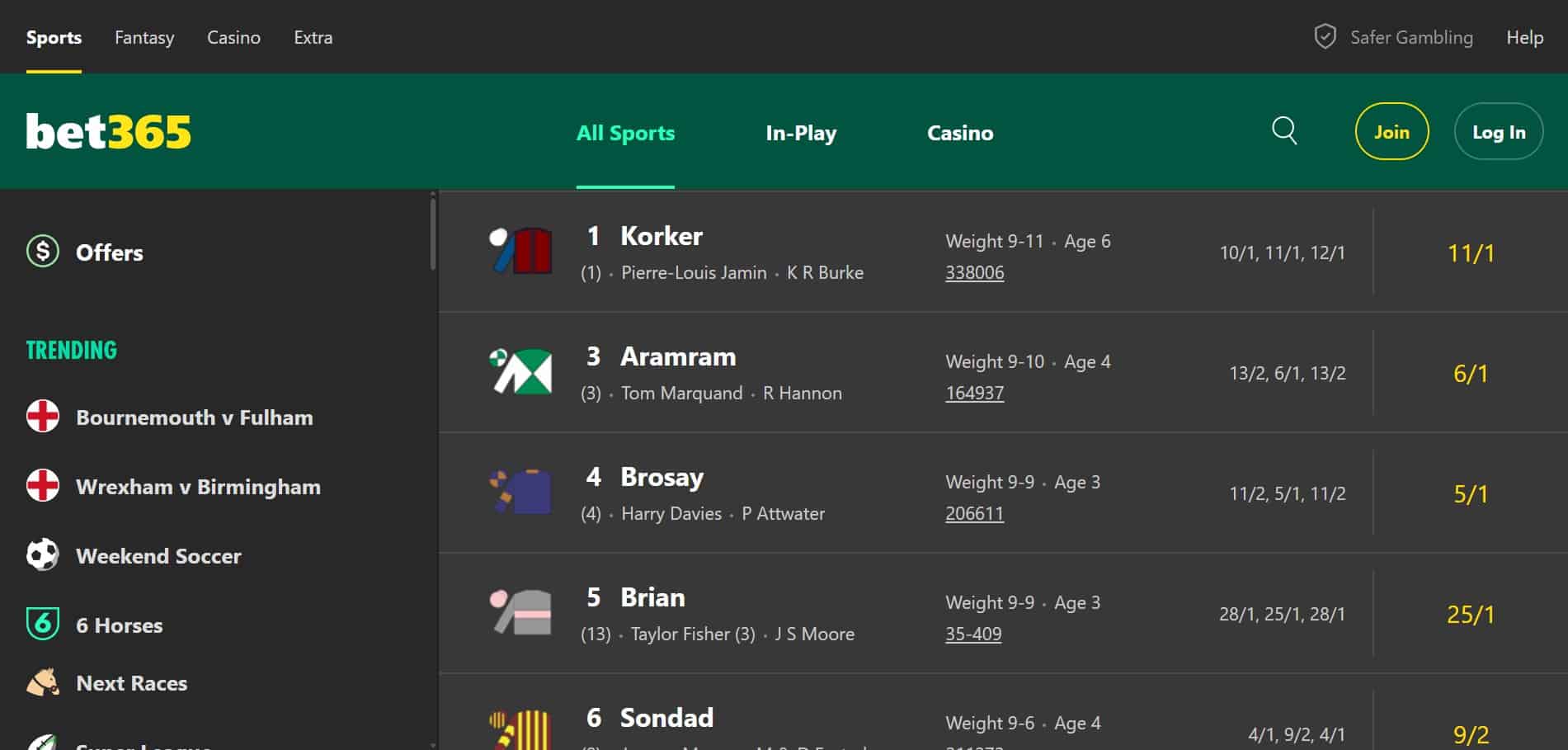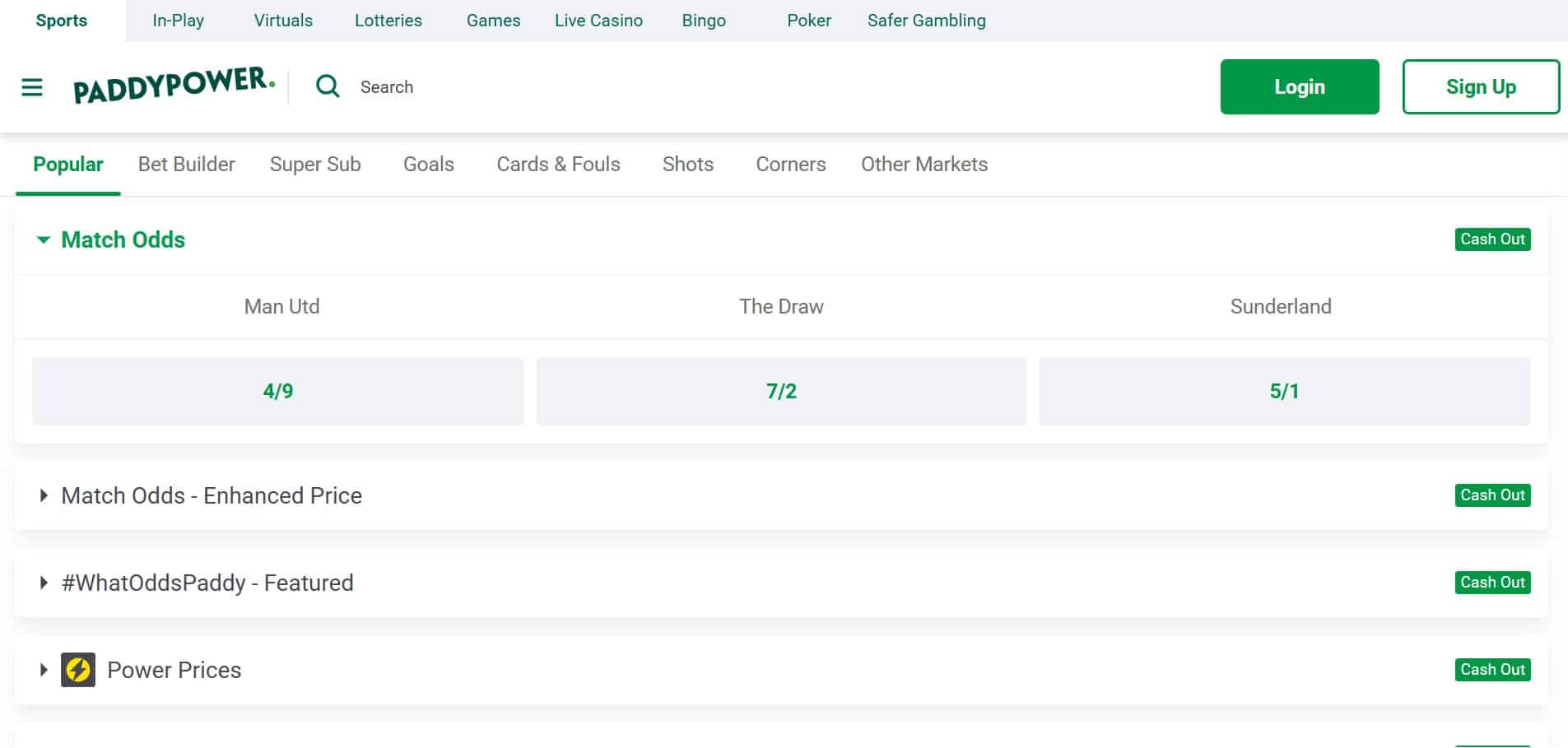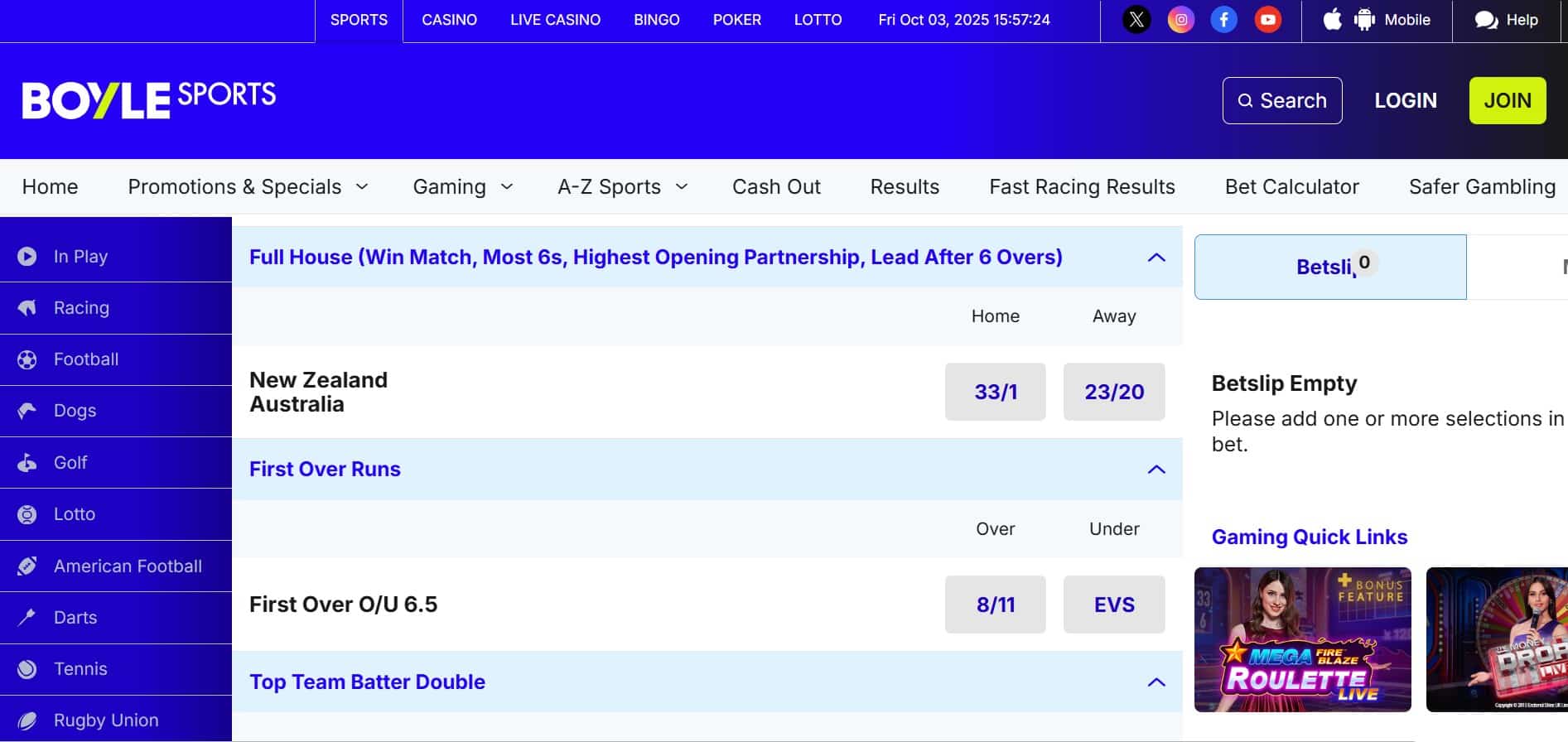Betting Odds Explained: How Odds Work in Sports Betting
Ciara Dunleavy, Senior Editor
Last Updated: 03/10/2025
Matteo Farina, Senior Editor
Fact-checker
If you’re looking to get betting odds explained in detail, we can help. This is your essential guide to understanding how betting odds work in sports betting so you can make smarter, more confident wagers.
We’ll explain decimal, fractional, and American odds. You can learn how to read them, what they mean for payouts, and how they shape strategy and influence betting edge.
- Show full guideShow less
Understanding Betting Odds in the UK
Betting odds are numerical representations of the likelihood of a specific outcome occurring in a sporting event. They are essential components at UK betting sites, as they show two important things.
- Reflecting Probability: Betting odds indicate how likely a bookmaker believes an event is to happen. For instance, a football team with very short odds is seen as the favourite to win, while a team with longer odds is considered the underdog with a smaller chance of victory.
- Calculating Winnings: Odds also determine how much money you could win. Higher odds offer larger payouts relative to your stake, but this typically means the event is less likely to occur.
In UK sports betting, odds play these key roles within different formats. So, if you’re learning how to bet on horse racing or any other sport in British betting, it’s essential to learn them.
Odds are more commonly displayed in fractions in the UK (e.g., 5/1 or 2/5). These represent how much you can win compared to your stake. For example, at 5/1 odds, a £10 bet would return £50 in winnings plus your original £10 stake.
Put simply, betting odds help punters weigh up value between their own predictions versus the bookmaker’s assessment. This is why it is essential to understand how odds work in your preferred format.
Fractional Odds (Common in the UK)
Fractional odds (e.g., 5/1, 2/7) is the preferred format at British and Irish bookies.
They show the profit relative to your stake: for example, 5/1 means you’ll win £5 for every £1 wagered, while 2/7 means you’ll get back £2 for every £7 you bet.
➡️ Formula for Payout:
Profit = Stake × (Numerator ÷ Denominator)
Total Return = Profit + Stake
Example (5/2 odds):
- Profit = £10 × (5 ÷ 2) = £25
- Total Return = £25 + £10 = £35
🔢 Implied Probability Formula:
Implied Probability (%) = Denominator ÷ (Numerator + Denominator) × 100
Example: 5/2 → 2 ÷ (5 + 2) = 0.285 → 28.57%
Summary
Bet Odds Stake Profit Total Return Implied Probability Example 5/2 £10 £25 £35 28.57% Decimal Odds (Popular in Europe)
Decimal odds, which are more abundant on European betting sites, are pretty straightforward.
The number shows the total return you’ll receive for every £1 wagered, including your original stake.
➡️ Formula for Payout:
Payout = Stake × Decimal Odds
Example:A £10 bet at 2.50 odds will return £25 (£10 × 2.50), including the £10 stake.
🔢 Implied Probability Formula:
- Implied Probability (%) = (1 / Decimal Odds) × 100
- Example: 1 ÷ 2.50 = 0.40 → 40%
Summary
Bet Odds Stake Payout Profit Implied Probability Example 2.50 £10 £25 £15 40% American Odds (US/Moneyline)
American odds are mainly used for US sports and can be found on offshore betting sites and are, of course, are ubiquitous in the USA.
Often referred to as “US” or “moneyline” odds, there are two American odds types:
- Positive Odds (+): show profit from a £100 bet.
- Negative Odds (−): show how much you need to bet to win £100.
➡️Payout Formulas:
- Positive Odds: Profit = (Odds ÷ 100) × Stake
- Negative Odds: Profit = (100 ÷ |Odds|) × Stake
➡️ Examples:
- Positive Odds: +150 → £10 bet = £15 profit, £25 total return
- Negative Odds: -200 → £10 bet = £5 profit, £15 total return
🔢 Implied Probability:
- Positive Odds: 100 ÷ (Odds + 100) × 100 → +150 = 40%
- Negative Odds: |Odds| ÷ (|Odds| + 100) × 100 → −200 = 66.67%
Summary
Bet Odds Stake Profit Total Return Implied Probability Example +150 £10 £15 £25 40% Example -200 £10 £5 £15 66.67% Understanding Implied Probability in Betting
You may have come across the term implied probability as it is a key concept in sports betting. It’s crucial to know about it if you plan to be a judicious bettor.
📈 What is Implied Probability?
Implied probability refers to the chance of an outcome happening, as suggested by the odds provided by a bookmaker. This is crucial for comparing your own predictions with the bookmaker’s approximations and identifying value bets.
Value bets are best explained as when your prediction of an event’s likelihood is more favourable than theirs. This means the payout is high enough to warrant a bet.
📊 How to Convert Odds into Probability
Odds formats can be translated into implied probability, including fractional odds which are common in the UK. Here’s how it works.
Implied Probability Formulas
📱 Decimal Odds: Implied Probability (%) = (1 ÷ Decimal Odds) × 100
➗ Fractional Odds: Implied Probability (%) = Denominator ÷ (Numerator + Denominator) × 100
➕ American Positive Odds: Implied Probability (%) = 100 ÷ (Odds + 100) × 100
➖ American Negative Odds: Implied Probability (%) = |Odds| ÷ (|Odds| + 100) × 100
Why Implied Probability Matters for Punters
Whether you’re betting on F1 or working out your cash out for football, there will be a probability involved in every wager you place.
This is why it matters.
- Spotting Value Bets: If you think a football team has a 65% chance of winning but the odds imply only 50%, you may have found a value bet.
- Avoiding Poor Bets: Implied probability helps you steer clear of wagers where the odds don’t match the true risk.
- Managing Your Bankroll: Understanding probability lets you set realistic expectations and avoid chasing unlikely wins.
How Bookmakers Determine Odds in the UK
Understanding how bookmakers in the UK set their odds can give punters valuable insight. In addition to better understanding betting markets, it can help them make more informed, strategic decisions.
The Role and Objectives of Bookmakers
Bookmakers, or bookies as they’re often called in the UK, are businesses first and foremost. Their aim isn’t to perfectly predict outcomes but to balance wagers on all sides of an event to secure a guaranteed profit no matter the result.
If you study UK betting and gaming statistics, you’ll see revenue increase year by year. Bookies achieve this by offering odds that attract bets on all possible outcomes, while factoring in a profit margin, commonly referred to as the overround or bookmaker’s edge.
💡Remember: Bookies don’t rely on guesswork. Instead, they use sophisticated statistical models, past data, and up-to-the-minute information to set odds that reflect both real probabilities and punter behaviour.
Key Factors That Influence Odds in the UK
When setting odds, UK bookmakers consider a variety of betting terms and factors. Whether it’s straight or acca bets, they need to ensure accuracy and profitability.
Some of these factors include:
- Form of Teams or Players: Recent performances, winning streaks, or poor runs impact how likely an outcome is perceived.
- Injuries and Team News: Injuries to star players or last-minute changes in the line-up can significantly alter the odds.
- Head-to-Head Records: Historical results between two teams or players can sway odds, especially in rivalries.
- Venue and Home Advantage: Playing at home often gives teams a boost, particularly in football or rugby.
- Weather Conditions: For outdoor sports like cricket or golf, weather conditions such as rain or wind can have a big influence on performance.
- Public Sentiment and Betting Trends: Odds are adjusted based on how money is placed. For example, if a large number of bets are placed on one team, the odds may shorten to discourage further betting on that side.
- Expert Analysis and Technology: Bookmakers use algorithms and expert insights to quickly adjust odds as new information becomes available.
Different Types of Betting Markets and Their Odds
Sports betting goes beyond predicting a match winner. This is because each market has its own rules, strategies, and odds.
Understanding them allows punters to find new opportunities and make informed choices. This has never been truer with the advent of Bet Builder and other creative wager types.
✔️ Match Result Bets
Match result bets are the simplest form of wagering as you pick who wins or if the game or tie will be drawn.
These bets are especially popular in sports like football, rugby, and tennis.
How the Odds Work:
- Fractional odds: A favourite might be 4/6 (stake £6 to win £4). An underdog could be 5/1 (stake £1 to win £5).
- Decimal odds: The same bets would be 1.67 for the favourite and 6.00 for the underdog. Multiply stake × odds for total return.
Example:
🚀 Team A: 4/6 (stake £6 → win £4)
🎯 Team B: 5/1 (stake £1 → win £5)
✔️ Handicap Betting
Handicap betting levels the field when one side is heavily favoured. A handicap (or spread) is applied to balance the contest.
These bets are common in high-scoring sports like cricket and basketball.
How the Odds Work:
- Both sides often sit around 10/11 (stake £11 to win £10).
Example:
If you back Team A, they must win by 7+ points. Team B covers the spread by losing by 6 or fewer (or winning outright).
🚀 Team A: −6.5
🎯 Team B: +6.5
✔️ Over/Under Betting (Totals)
Instead of backing a winner, you bet whether the total goals or points in a match will be over or under a line set by the bookmaker.
How the Odds Work:
- Both sides are usually priced at 10/11 (bookie’s margin stops it from being evens on both sides).
Example:
🚀 Over 2.5 Goals: 10/11
🎯 Under 2.5 Goals: 10/11
If the match ends 2–1 (three goals), “over” wins. This market is especially popular in football.
✔️ Outright Betting
Outright bets cover long-term outcomes, such as who wins the Premier League, the Six Nations, or Wimbledon.
Betting outrights can sometimes carry higher risk but often deliver bigger payouts.
How the Odds Work:
- These odds fluctuate with form, injuries, and performance.
Example:
🚀 Arsenal to win the Premier League: 6/1 (a £10 bet wins £60 profit).
✔️ Specials Bets
Specials are especially popular during major events like the FA Cup Final, The Ashes, or the World Cup.
They’re known in the US as prop bets, but both simply focus on individual or unusual outcomes that don’t affect the final score.
Examples include:
- First Goal Scorer
- Number of Corners
- Winner of a Coin Toss
How the Odds Work:
Odds vary. Some prices on betting apps and sites are modestly priced while others carry big payouts for unlikely events.
For example, a player scoring 5 goals in a match.
How Odds and Risk Vary Across Markets
Bet Type What it Is Breakdown Match Result Straightforward choice of winner/draw & easy to understand Lower payouts on favourites with better value on underdogs Handicap Betting Balances contests & offers value on mismatches Moderate risk & adds excitement when one team is heavily favoured Over/Under (Totals) Bet on total goals/points rather than winner Risk depends on team styles (attacking vs defensive) Outrights Long-term bets on tournaments or seasons High potential payouts; funds tied up for longer Specials Fun & varied bets on unique outcomes Ranges from low-risk moderate bets to high-risk, large payout options By exploring different betting markets and understanding how odds work, punters can diversify their strategies and increase the chances of placing a winning bet.
Whether you’re backing your favourite football team or predicting events winners on Esports betting sites, the key is to bet responsibly and enjoy the thrill of the game.
Mastering Betting Odds to Make Smarter Wagers
Betting odds are a key tool for placing more informed and strategic bets. Successful punters don’t leave it to chance; they study the odds, identify value, and manage their risks wisely.
⚡Why Comparing Odds Across Bookies Matters
Not all bookmakers offer the same odds on the same event, and those small differences can really add up over time.
For instance, one bookie might list a football match at 2.10, while another offers 2.30 for the same result. That difference might seem minor, but consistently choosing better odds can make a significant impact on your profits.
🧐 Example: If you bet £100 at 2.10, your profit is £110. If you place the same £100 bet at 2.30, your profit jumps to £130—that’s a £20 difference on just one wager.
💡 Tip: Use odds comparison sites or apps to shop around and find the best prices before placing your bets.
⚡Understanding Value Betting
A crucial part of smart betting is identifying value bets that offer potential profit.
Value betting involves placing wagers where the implied probability of the odds is lower than your own estimation of the event’s likelihood.
🧐 For example: If a bookmaker offers odds of 3.00 (implied probability of 33.3%) but you believe the event has a 50% chance of happening, that’s a value bet.
This approach isn’t about betting on the most obvious winner—it’s about finding overpriced outcomes that pay more than they should. Long-term profits come from spotting these opportunities and staying consistent.
⚡Using Odds to Manage Risk
Odds aren’t just about potential payouts, they also reflect the risk involved. Whether you’re using boxing betting sites or wagering on tennis, this can influence how often a bet wins.
Higher odds signal a less likely outcome, while lower odds suggest a more likely one. Understanding this balance can help you make better decisions and improve your chances of winning.
Here are a few ways to manage risk effectively:
- Avoid making bets based on emotion or bias.
- Spread your stakes across both safer and riskier bets for balance.
- Use hedging and arbitrage strategies to reduce potential losses.
🧐 Example Strategy: Instead of putting £100 on a £5 long shot, you might split that across two £2.50 bets to hedge your risk while maintaining a decent return.
By mastering these strategies and sharpening your understanding of betting odds and how to understand betting odds, you can approach punting with confidence. Better yet, you can maximise your chances of long-term success.
Common Misunderstandings About Betting Odds
Here are some common ideas we’d like to dispel about odds.
👉 Odds Are Not Precise Predictions: They represent probability and the bookmaker’s strategy.
👉 Higher Odds Don’t Guarantee Big Wins: Higher odds reflect a lower likelihood of winning and come with greater risk.
👉 Odds are Constantly Changing: Factors like news, injuries, and betting activity can all impact odds.
Final Thoughts
Understanding betting odds is crucial for becoming a more knowledgeable and strategic punter, especially when you learn to calculate the probability of outcomes. Odds represent the probability of an outcome and are essential for calculating potential winnings.
By mastering how odds work, you can calculate the implied probability of an event and decide if a bet offers good value. Furthermore, comparing odds across different bookies can help you find the best deals and maximise your returns.
Responsible gambling is just as important, so always stick to your budget and never bet more than you can afford to lose. Keep educating yourself and refining your approach to enjoy a smarter and more balanced betting experience.
FAQs
How do betting odds work in sports betting?Odds work by indicating the likelihood of a particular outcome and how much you can win based on your stake. They are typically represented in fractional or decimal odds in the UK.How are betting odds calculated by bookmakers?Bookies calculate odds using implied probability, market demand, and historical data. Bookmakers set odds based on the likelihood of a particular outcome, while factoring in a margin for profit.How do you convert betting odds into probability?For fractional odds, divide the denominator by the sum of both numbers and multiply by 100. For example, 2/1 becomes 1 ÷ (2+1) × 100 = 33.3%. For decimal odds, use 1 ÷ decimal value × 100.What do American betting odds mean and how do they work?American betting odds use a positive or negative number to show how much you’ll win or need to bet. A minus sign (e.g., -150) shows how much you need to stake to win £100, while a positive number (e.g., +200) shows how much you’d win from a £100 stake.How do European decimal odds differ from fractional odds?European decimal odds are typically represented as a single number (e.g., 3.00), which includes your original stake. This format is easier to calculate, as you simply multiply your stake by the decimal value to find your total return. In contrast, fractional odds (e.g., 2/1) show the profit only. Many UK betting sites now offer both options to suit different preferences.How can I convert fractional odds into decimal form?To convert fractional odds into decimal form, divide the fraction, add 1, and you have your decimal value. For instance, to convert fractional odds of 5/2: 5 ÷ 2 = 2.5 + 1 = 3.5. This means a £10 stake returns £35.Resources
Ciara Dunleavy, Senior Editor
Ciara is an esports journalist and casino expert who contributes much to our site. A native of the US, Ciara brings nearly a decade of experience writing for UK audiences about slots, online casinos, and table games. When not at her desk, you can find Ciara cheering on the Green Bay Packers or walking her dog, Jet.
This article has been Fact-checked by Matteo Farina
We prioritize accuracy, objectivity, and depth in every piece of content we produce. Our rigorous editorial standards ensure that all information is carefully sourced and fact-checked. Each article is meticulously reviewed by experienced editors and leading technology professionals to maintain the highest level of credibility and relevance. This commitment guarantees our readers content they can trust and rely on.
From breaking news and in-depth match analysis to exclusive interviews and behind-the-scenes content, we bring you the stories that shape the esports scene.
40k+Monthly Visitors
100%User Satisfaction
10+Years experience
Popular Pages











